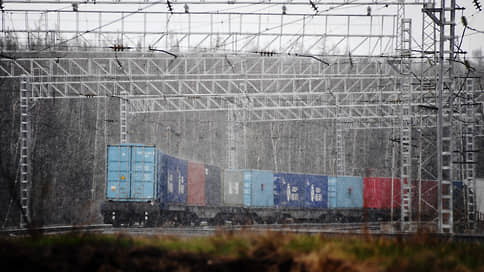Chinese containers headed to the EU
[ad_1]

Rail transport of containers from China to the EU in transit through Russian territory, which froze after the outbreak of hostilities in Ukraine, is being restored. In the first quarter, they grew by 44%, to 90 thousand TEU, which is not much less than pre-crisis volumes. Market participants confirm the growth of transit. European consignees are attracted to the route by relatively short terms – in maritime traffic they have lengthened after the departure of container lines from the Red Sea due to attacks by the Houthis. The political situation does not affect transit through the Russian Federation due to the largely non-sanctioned nature of the cargo.
Container transit between China and Europe via Russia increased by 44% in the first quarter, said Deputy General Director of Russian Railways OJSC Alexey Shilo: “We transported almost 90 thousand TEU.” The top manager admitted that the impact of events in the Red Sea could lead to clients once again paying attention to the trans-Russian corridor. At the same time, “the corridor has been formed quite a long time ago, it is technologically the most developed, the speed of delivery of goods from the borders of China to the borders of the EU is still 5-7 days – this is 3-5 times faster than what our colleagues transported previously.” According to Mr. Shiloh, freight rates were quite low, so goods for which there was no need for high speed were sent by sea, but for urgent goods the land route still remained the most attractive.
90 thousand TEU per quarter is less than before the crisis, but not by much. Thus, in the first quarter of 2021, Russian Railways transported 105.8 thousand TEU in transit from China to Europe. In early March, the FT reported, citing market participants, that requests for rail transit through the Russian Federation increased by 40% after the Houthi attacks in the Red Sea.
Mr. Shilo clarified that in general the volume of traffic along the transit corridor has not decreased significantly: the structure has changed. “That is, the lost volume of purely transit traffic was replaced by goods from Belarus and Russia to China,” he noted. One of the trends this year was the growth of transit between Belarus and China: “It also increased by 68% compared to the same period last year, we transported a total of about 135 thousand TEU.” “If previously we transported quite a lot from the EU to China, now we deliver more cargo from friendly countries,” noted Alexey Shilo.
UTLC ERA (an operator of China-EU container transit through the territories of Russia, Kazakhstan and Belarus, owned by the railway administrations of three countries) reported that at the end of 2023, the total volume of transportation in the company’s services amounted to 674 thousand TEU. On the China-Russia route, 197.7 thousand TEU were transported (an increase of 26.6%), China-Belarus – 58.5 thousand TEU (an increase of 323%). In the direction from Russia and Belarus to the east in 2023, 206.6 thousand TEU were transported (an increase of 107%). In share terms in 2023, imports amounted to 38%, transit and exports accounted for 31% each, respectively. In the first quarter of this year, according to preliminary data, the total volume of transportation by UTLC ERA amounted to 176 thousand TEU, the share of transit was 50%.
Market participants confirm the trend. ModernWay CEO Nikolai Olshansky says that, according to information from Chinese colleagues, the growth in transit traffic in the China-Europe direction compared to 2023 is about 20–30%, although the volume of transportation fell relative to the peak values in January, which was caused by the onset of an acute crisis in Red Sea. This year, container deliveries by rail from China to the EU in transit through the Russian Federation have indeed resumed, says Dmitry Sukhoversha, head of multimodal transportation at FM Logistic in Russia. “We can only speculate on the real reasons for the renewed demand from European cargo recipients,” he notes. “This is probably due to economic factors and the advantages of this route compared to alternative deep sea services, taking into account the situation in the Red Sea.” Changes in the routes of ocean-going vessels through the Cape of Good Hope have led to an increase in transit time by an average of 10-14 days or more depending on the base port of disembarkation, an increase in operating costs and freight rates, as well as disruption to voyage schedules on one of the main trade routes between Asia and Europe, says Fedor Tokarev, national manager for intermodal transportation at Noytech Supply Chain Solutions: “This created the need to search for alternative routes, and transit by Russian railways seems to be the most optimal solution.”
Some market participants believe that the Red Sea factor in the growth of interest in land transit through the Russian Federation is not so significant. SOTA Logistic Business Development Director Igor Chernyshev says that trade between China and the EU is increasing, and the land corridor bypassing Russia through Central Asia and the Caucasus does not yet have the necessary infrastructure capable of handling such a volume of cargo. “Multimodal transportation along the North-South international transport corridor, due to numerous transshipments from one transport to another, is 30% more expensive than direct rail transit through Russia,” he adds.
According to Nikolai Olshansky, due to the fact that prices for rail transportation from China to Europe have always been 1.5–2 times higher than sea freight rates, the main cargo in this direction are electronics, cars, auto parts, equipment, as well as others goods for which transit time is critical. “For rail transport it averages 12-25 days instead of 40-60 days by sea,” he says. Igor Chernyshev notes that mainly consumer goods that are not subject to sanctions go from China to the EU, “so the EU also benefits from a direct route.”
[ad_2]
Source link





